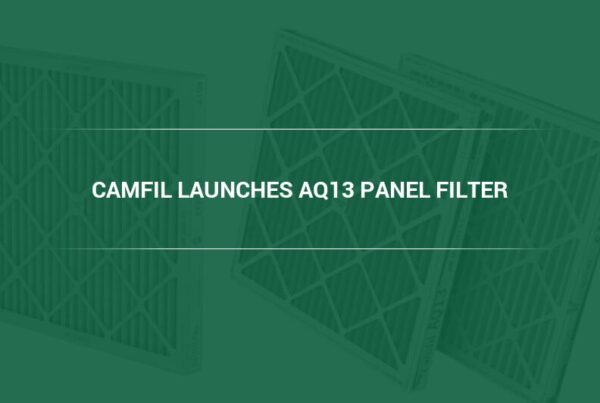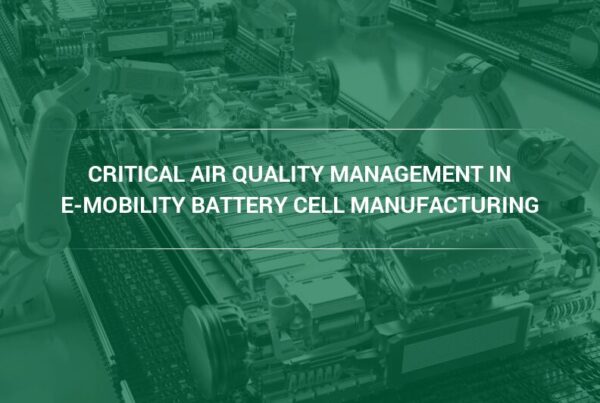Indoor air quality (IAQ) in K-12 schools significantly impacts student well-being and academic success. Good IAQ enhances cognitive function, productivity, attendance and overall health. Conversely, poor IAQ can facilitate the spread of contagious illnesses spread through airborne respiratory droplets and aerosols. In addition, indoor pollution sources like volatile organic compounds (VOCs) and particulate matter contribute to degraded air quality.
Several factors make school settings vulnerable to indoor air pollution:
- Airtight construction methods that trap contaminants
- Energy conservation measures that lead to lower ventilation rates
- Synthetic materials in building and furnishing that release harmful compounds
- The widespread use of personal care items, pesticides and cleaning agents
Fortunately, poor IAQ in schools can be controlled through the use of high-efficiency air filters in HVAC systems. Air filtration improves ventilation by capturing airborne pollutants. This purification process ensures that recirculated indoor air remains free from particulates. In cases where HVAC systems cannot support high-efficiency filters, standalone air purifiers can be used as a supplement to remove gaseous pollutants from the air.
Despite these solutions, implementing IAQ improvements in K-12 schools often encounters obstacles. This article explores the most common barriers and provides strategies to overcome them.
Identifying the Barriers to Safe IAQ
Old Facilities
Many K-12 schools operate in buildings with outdated ventilation systems that do not meet modern standards for air exchange rates, filtration or energy efficiency. Over time, these older structures accumulate dust, mold and pollutants. Furthermore, schools are densely populated, typically accommodating four times more people than equivalently sized office buildings. The number of occupants places additional strain on ventilation systems. Regular maintenance, upgrades and renovations are essential to address these issues.
Financial Constraints
School districts often face financial limitations and funding for ventilation upgrades competes with other essential needs. Inadequate funding for upgrades and maintenance can hinder efforts to improve IAQ.
Insufficient Awareness and Education
Some school administrators, teachers, staff and parents may not fully understand the importance of good IAQ. Awareness campaigns and educational programs are necessary to emphasize the impact of air quality on student health, learning and overall well-being.
Maintenance Challenges
School facilities often house multiple HVAC systems, each requiring regular maintenance. Some schools resort to using portable classrooms or repurposed buildings not originally designed for educational purposes. These adaptations add complexity to ensuring healthy IAQ. Even when suitable HVAC systems are in place, proper maintenance is essential. Tasks like changing filters, cleaning ducts and monitoring system performance are essential but can be overlooked due to limited staff or competing priorities.
Resistance to Change
Implementing new ventilation strategies requires buy-in from various stakeholders, including school boards, administrators, teachers and parents. Resistance to change, fear of disruption or skepticism about the effectiveness of upgrades can impede progress.
Inconsistent Policies and Guidelines
While federal agencies like the Centers for Disease Control and Prevention (CDC) and the Environmental Protection Agency (EPA) provide guidance, there is no uniform national policy on IAQ in schools. State and local regulations vary, leading to inconsistencies in implementation.
Complex Decision-Making Process
School districts must navigate a complex decision-making process involving multiple departments, legal considerations and community input. Balancing short-term costs with long-term benefits can be challenging when initiating IAQ improvements.
Equity Issues
IAQ improvements should be equitable across all schools, regardless of location, socioeconomic status or student demographics. High-poverty districts may struggle more due to limited resources.
Lack of Customized Solutions
Universal approaches do not work for IAQ in K-12 facilities because each school building has unique characteristics, occupancy patterns and environmental factors. Customized ventilation and air filtration solutions are necessary to address specific challenges faced by individual schools.
Achievable IAQ Solutions
Consulting with an air filtration expert experienced with K-12 facilities can provide proper recommendations on filter cleaning, replacement and preventive measures that improve IAQ and save money over time. Facility operators should collaborate with air filtration professionals to ensure that the building’s air filters are rated to capture particles of varying sizes, including large, small, nuisance and hazardous particles. Even the most advanced HVAC systems cannot effectively clean the air without properly selected and installed air filters tailored for the task.
“Many people think that improving IAQ is prohibitively expensive for schools, especially those with tight budgets. While some comprehensive upgrades may require investment, there are cost-effective strategies that schools can adopt, like conducting regular system maintenance and using long-life air filters to reduce replacement frequency and enhance energy efficiency,” says Mark Davidson, a technical services marketing manager at Camfil.
Air Filtration Technology
Improving the air quality in K–12 schools relies heavily on proper ventilation and air filtration. The HVAC system plays the critical role in ventilating, heating, cooling, circulating and purifying the air, significantly influencing the distribution and removal of pollutants. Effective ventilation introduces fresh air and removes polluted indoor air, while air filters clean the air within HVAC and air purification systems by allowing clean air to pass through while trapping pollutants.
These filters are strategically installed within the system to prevent contaminants from entering the indoor space and are made from various materials designed to trap different pollutants. For example, HEPA filters capture very small particles, such as allergens and pathogens. Activated carbon filters capture odors, gases and VOCs.
Economic Advantages of Long-Life Air Filters
In K-12 school facilities, it is standard practice to use multiple HVAC systems, each equipped with several air filters. Due to budget constraints, staff often choose the most affordable air filter options that meet operational requirements. Yet, this approach can backfire, as economy air filters tend to clog rapidly, restrict airflow and use more energy. Consequently, these filters typically need to be changed three to four times a year, resulting in significant ongoing costs.
A cost-saving strategy for air filtration in schools is to invest in long-lasting filters that do not require frequent replacement. While these high-efficiency filters cost more upfront, they maintain their performance over a longer period, outlasting their standard counterparts. This reduction in the number of replacements needed means that, over time, the overall expenses for managing air filters with high-efficiency options are significantly less than those incurred with the more economical, yet less durable, filters.
In addition, long-life filters are engineered to maintain ideal airflow, reducing the strain on HVAC systems as they circulate air through ducts and vents. This operational efficiency leads to lower energy usage, resulting in monthly savings. Implementing high-efficiency air filters also decreases the amount of labor needed to maintain air handling systems due to their extended service life. The longer lifespan also reduces landfill waste because fewer air filters are disposed of.
MERV Ratings
The selection of air filters depends on several factors, including the type and size of airborne particles, as well as the Minimum Efficiency Reporting Value (MERV). These MERV ratings assess how effectively an air filter can remove particles of varying sizes. During the pandemic, a task force organized by The American Society of Heating, Refrigerating, and Air-Conditioning Engineers (ASHRAE) recommended a minimum filtration efficiency target of MERV 13. However, it is essential to recognize that not all filters rated MERV 13 consistently maintain their stated efficiency throughout their lifespan. To address this, ASHRAE introduced the MERV-A rating, which designates filters that have undergone additional testing to ensure their efficiency lasts over time. For optimal performance, it is advisable for K–12 schools to use MERV-A-rated air filters whenever possible.
Air filters rated a minimum of MERV 13/13A installed in HVAC systems capture an average of 85 percent of particles 1 micron and larger and 50 percent of particles larger than 0.3 microns. A MERV 14/14A filter eliminates an average of 75 percent of particles larger than 0.3 microns, while a MERV 16/16A filter targets 95 percent removal of particles larger than 0.3 microns.
It is important to consider the specific capabilities of the HVAC system, which may limit the use of higher-rated MERV filters, such as MERV 14A. In cases where these are not compatible, it is best to select the highest MERV-A-rated filter that the system can accommodate. Many rooftop HVAC systems are designed to only hold 2-inch deep pleated filters which generally means the maximum efficiency is MERV 13
HEPA filters, known for trapping up to 99.97% of particles larger than 0.3 microns, may not be suitable for all HVAC systems. However, they are frequently used in individual room air purifiers that focus on particular zones. When choosing HEPA filters, ensure they have been individually tested and certified to confirm their authenticity.
Air Filtration Maintenance
After installing new, high-quality, long-life air filters, it is essential to establish a comprehensive maintenance plan and schedule. This proactive approach enables building occupants to breathe cleaner air and that IAQ remains optimal. Regular inspections of air filters are crucial to identify signs of damage, debris and ensure tight seals. Additionally, cleaning the area around HVAC equipment helps prevent the accumulation of dust and dirt. By adhering to a scheduled replacement of air filters, school maintenance administrators can avoid unplanned expenses and keep the system operating efficiently.
Depending on the specific equipment at a school facility, air filter professionals can measure system pressure and performance to ensure proper airflow and maintain air quality. They can also alert personnel to potential health and safety violations. Providing training to employees helps raise awareness of potential issues so that they can be promptly reported. Lastly, documenting all maintenance work allows for trend analysis and ensures timely updates to the maintenance plan when necessary.
Air Filtration Expertise
Camfil has the real-world expertise and product lines that support all phases of air filtration to improve IAQ in K-12 schools:
- Farr 30/30® high-capacity pleated panel air filter with true MERV 8A maintained efficiency, ISO 16890 ePM10 50 percent, and an industry-leading 5-Star Energy Cost Index rating.
- 30/30® Dual 9 with true MERV 9A maintained efficiency, ISO 16890 ePM10 55 percent, an industry-leading 5-Star Energy Cost Index rating, and a guaranteed service life of 9 to 12 months.
- AQ13 is the ideal air filter where MERV 13 efficiency is required. Available in one-, two- or four-inch depths, this filter delivers a long service life and is suitable for most rooftop air handling units.
- Durafil® ES3: High-capacity, high-efficiency, V-style air filter available in MERV 13A, 14A, and 16A with an industry-leading 5-Star Energy Cost Index rating.
- Durafil® Compac: Same high-performance V-style air filter as the Durafil ES3 but in a narrow six-inch depth for systems with limited space.
- Hi-Flo® ES: Multi-pocket, high-efficiency air filter with tapered pleats and pockets available in MERV 11A, 13A, 14A, and 15A with an industry-leading 5-Star Energy Cost Index rating.
- Molecular / Odor Control: Remove molecules, gases, and vapors from the air and are tested according to ISO 10121 or ASHRAE 145.2. The molecules that makeup gases are typically 1,000 times smaller than the most penetrating particles that pass through HEPA and ULPA filters but can be controlled with filters using activated carbon molecular media.
- CamCleaner CC500: Powerful large room air purifier designed to deliver 500 cfm of 99.99% certified HEPA filtration or can be ducted to create a negatively pressurized isolation area.
Conclusion
Prioritizing IAQ is paramount in creating healthier learning environments. Investing in improving IAQ in K-12 schools is also an investment in students’ well-being, cognitive development and overall health. Safe IAQ is not an afterthought—it is a foundational element of quality education.
To learn more about Camfil’s air filtration solutions for K-12 educational facilities, visit https://www.camfil.com/en-us/industries/commercial-and-public-buildings/schools–universities.
¹https://www.epa.gov/iaq-schools/framework-effective-school-iaq-management
⁴https://journalistsresource.org/education/indoor-air-quality-schools-student-learning-health/
⁵https://www.epa.gov/iaq-schools/reference-guide-indoor-air-quality-schools



